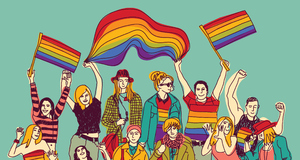|
Homonationalism and the Death of the Radical Queer
As exemplified by Paur, the most explicit queer production of exceptionalism can be found within the gay media commentary surrounding the “torture sex scandal” at Abu Ghraib. With the release of photos in 2004 depicting torture through a specter of homosexual acts, Paur notes that the majority of the gay press emphasizes the obvious homophobia of the American soldiers, while ignoring how race and sex intertwines with sexuality in such acts of torture. In turn, the gay press constructed an Orientalist “Muslim sexuality,” that enables American acts of necropower.
Indeed, when the Islamic LGBTQ organization Al-Fatiha stated that such torture is “an affront to their masculinity” and defies Islam’s strong emphasis on “sexual privacy and modesty,” such queer organizations reproduces the orientalist “taboo of Muslim homosexuality” that is required for American exceptionalist military adventures. By highlighting the sexual “repression” of the Arab prisoners, and subsequently effacing the hypersexual excesses of the American guards, one can clearly see the performative privileges of Foucault’s “speaker’s benefit”: to articulate sexual knowledge is to present oneself as sexually liberated. Thereby, the gay media secured U.S. expectionalism by manufacturing “Muslim” and “homosexuality” as mutually exclusive.
With the war on terror, the queer assemblages of the suicide bomber deconstructed the collusion of sexual liberalism with American nationalism. The depictions of masculinity most rapidly disseminated in the war on terror are the failed, perverse, and emasculated terrorist body. With their femininity indicated as the source of their malfunction and pathology, Paur emphasizes the queerness innate within the construction and categorization of the terrorist body. In other words, the definition of the “terrorist” is based on necropolitical notions of perversion, deviance, and deformity. To recognize such a queer construction provides a subject-driven temporality alongside a method-driven temporality. Such notions of corporal reordering and evolving time and space allows the term “queer” to be a matter of Deleuzian assemblage and not a static entity, as is the theory of intersectionality.
According to Gilles Deleuze and Felix Guattari, the changing state of things draws together enunciation and dissolution, causality and effect with implicated networks of constructs. Through the materiality of bodies with its speed and intensity, assemblages attune to circumstance and affective temporalities and space. Most importantly, given the heightened death-machine of nationalism, assemblages allow for “being” and “becoming.” In turn, assemblages disrupt the linearity and stability of liberal subjects and thereby work against American expectionalism and its global empire.
Achille Mbembe’s “Necropolitics” utilizes the modalities of the suicide bomber to emphasis the queer reorientation of space and time. With such a body machined with metal and flesh, the destruction of the able body is the ultimate form of resistance and self-preservation. As death is a prerequisite to becoming a suicide bomber, his/her being is sexually perverse. As Puar notes, “the intimacy of weapon with body reorients assumed spatial integrity...the ontology of the body renders it a newly becoming body.” In other words, the illusion of the sovereign compels him/her to expose the collectively imposed boundaries and limits. It is also connects to affective queerness, with death acting as a means of redemption and freedom from colonial bondage. The suicide bomber, thereby, utilizes technologies of death as a method of becoming while defying necropolitical technologies of control, surveillance, and extermination.
Queer liberalism and its intersection with American nationalism resulted in the death of the 1990s queer radicalism. Nonetheless, through the conception of queer assemblages as a matter of temporality and interchanging, Deleuzian disruptions of time and space end the necropower of American expectionalism. Moreover, it also disrupts the static entities within homonormativity and homonationalism, preventing the exclusion abjection of non-normative sexual desire and gender performativity. In turn, it will be possible to temporalize American national identity, dismantling its reliance on the abject other.
Butler, Judith. “Critically Queer.” In Bodies that Matter: Discursive Limits of ‘Sex.’ Routledge, 1993.
Butler, Judith. “Sexual Inversions.” In Discourses of Sexuality: From Aristotle to Aids. ed. Donna Stanon. Ann Arbor: University of Michigan Press, 1992.
Deleuze, Gilles, and Guattari, Felix. A Thousand Plateaus: Capitalism and Schizophrenia. Edited by Brian Massumi. University of Minnesota Press, 1987.
Duggan,Lisa. The Twilight of Equality? Neoliberalism, Cultural Politics, and the Attack on Democracy. Boston: Beacon, 2003.
Foucault, Michel. The History of Sexuality. New York: Vintage, 1980.
Mbembe, Achille. “Necropolitics.” In Public Culture, 15, (1). Durham: Duke University Press, 2003.
Paur, Jasbir. “Queer Times, Queer Assemblages.” In The Routledge Queer Studies Reader. London and New York: Routledge, 2013.
Paur, Jasbir. Terrorist Assemblages: Homonationalism in Queer Times. Duke University Press, 2007.
Reagan, Ronald.“Farewell Address to the Nation.” 11 January 1989. https://www.reaganfoundation.org/tgcdetail.aspx?p=TG0923RRS&h1=0&h2=0& sw=&lm=reagan&args_a=cms&args_b=1&argsb=N&tx=1749
Warner, Michael. ed.Fear of a Queer Planet. Minneapolis: Minnesota University Press, 1993.
Winthrop, John. “A Model of Christian Charity.” http://religiousfreedom.lib.virginia.edu/sacred/charity.html
- Even the language politics such as the term “equal marriage” convey a demand to include monogamous gay couples in heteronormative institutions. Examples of accentuated state regulation would be assessing the suitability of parents for child adoption, the eligibility for tax credits and federal benefits with the end of the Defense of Marriage Act, and spousal pathways to American citizenship.
- John Winthrop, “A Model of Christian Charity,” http://religiousfreedom.lib.virginia.edu/sacred/charity.html
- Ronald Reagan, “Farewell Address to the Nation,” 11 January 1989, https://www.reaganfoundation.org/tgcdetail.aspx?p=TG0923RRS&h1=0&h2=0&sw=&lm=reagan&args_a=cms&args_b=1&argsb=N&tx=1749
- Judith Butler, “Sexual Inversions,” in Discourses of Sexuality: From Aristotle to Aids, ed. Donna Stanon, (Ann Arbor: University of Michigan Press, 1992), 82.
- Michael Warner, ed.Fear of a Queer Planet(Minneapolis: Minnesota University Press, 1993), xxvii.
- Judith Butler, “Critically Queer,” in Bodies that Matter: Discursive Limits of ‘Sex,’ (Routledge, 1993), 235-236.
- Ibid, 223-224.
- Lisa Duggan,The Twilight of Equality? Neoliberalism, Cultural Politics, and the Attack on Democracy(Boston: Beacon, 2003), 50.
- Jasbir Paur, Terrorist Assemblages: Homonationalism in Queer Times, (Duke University Press, 2007), 37.
- Ibid, 41, 43.
- Michel Foucault, The History of Sexuality, (New York: Vintage, 1980), 10. Of course, Foucault’s work should not transparently apply to all cultural contexts, as he himself perpetuates oriental romanticism with concept of ars erotica.
- Jasbir Paur, “Queer Times, Queer Assemblages,” in The Routledge Queer Studies Reader, (London and New York: Routledge, 2013), 517-518.
- Michel Foucault, The History of Sexuality, 6.
- Jasbir Paur, “Queer Times, Queer Assemblages,” 520.
- Gilles Deleuze and Felix Guattari, A Thousand Plateaus: Capitalism and Schizophrenia, ed. Brian Massumi, (University of Minnesota Press, 1987), 260.
- Jasbir Paur, Terrorist Assemblages, 217.
- Achille Mbembe, “Necropolitics,” in Public Culture, 15, (1), (Durham: Duke University Press, 2003), 39.
Butler, Judith. “Critically Queer.” In Bodies that Matter: Discursive Limits of ‘Sex.’ Routledge, 1993.
Butler, Judith. “Sexual Inversions.” In Discourses of Sexuality: From Aristotle to Aids. ed. Donna Stanon. Ann Arbor: University of Michigan Press, 1992.
Deleuze, Gilles, and Guattari, Felix. A Thousand Plateaus: Capitalism and Schizophrenia. Edited by Brian Massumi. University of Minnesota Press, 1987.
Duggan,Lisa. The Twilight of Equality? Neoliberalism, Cultural Politics, and the Attack on Democracy. Boston: Beacon, 2003.
Foucault, Michel. The History of Sexuality. New York: Vintage, 1980.
Mbembe, Achille. “Necropolitics.” In Public Culture, 15, (1). Durham: Duke University Press, 2003.
Paur, Jasbir. “Queer Times, Queer Assemblages.” In The Routledge Queer Studies Reader. London and New York: Routledge, 2013.
Paur, Jasbir. Terrorist Assemblages: Homonationalism in Queer Times. Duke University Press, 2007.
Reagan, Ronald.“Farewell Address to the Nation.” 11 January 1989. https://www.reaganfoundation.org/tgcdetail.aspx?p=TG0923RRS&h1=0&h2=0& sw=&lm=reagan&args_a=cms&args_b=1&argsb=N&tx=1749
Warner, Michael. ed.Fear of a Queer Planet. Minneapolis: Minnesota University Press, 1993.
Winthrop, John. “A Model of Christian Charity.” http://religiousfreedom.lib.virginia.edu/sacred/charity.html
Endnotes
- Even the language politics such as the term “equal marriage” convey a demand to include monogamous gay couples in heteronormative institutions. Examples of accentuated state regulation would be assessing the suitability of parents for child adoption, the eligibility for tax credits and federal benefits with the end of the Defense of Marriage Act, and spousal pathways to American citizenship.
- John Winthrop, “A Model of Christian Charity,” http://religiousfreedom.lib.virginia.edu/sacred/charity.html
- Ronald Reagan, “Farewell Address to the Nation,” 11 January 1989, https://www.reaganfoundation.org/tgcdetail.aspx?p=TG0923RRS&h1=0&h2=0&sw=&lm=reagan&args_a=cms&args_b=1&argsb=N&tx=1749
- Judith Butler, “Sexual Inversions,” in Discourses of Sexuality: From Aristotle to Aids, ed. Donna Stanon, (Ann Arbor: University of Michigan Press, 1992), 82.
- Michael Warner, ed.Fear of a Queer Planet(Minneapolis: Minnesota University Press, 1993), xxvii.
- Judith Butler, “Critically Queer,” in Bodies that Matter: Discursive Limits of ‘Sex,’ (Routledge, 1993), 235-236.
- Ibid, 223-224.
- Lisa Duggan,The Twilight of Equality? Neoliberalism, Cultural Politics, and the Attack on Democracy(Boston: Beacon, 2003), 50.
- Jasbir Paur, Terrorist Assemblages: Homonationalism in Queer Times, (Duke University Press, 2007), 37.
- Ibid, 41, 43.
- Michel Foucault, The History of Sexuality, (New York: Vintage, 1980), 10. Of course, Foucault’s work should not transparently apply to all cultural contexts, as he himself perpetuates oriental romanticism with concept of ars erotica.
- Jasbir Paur, “Queer Times, Queer Assemblages,” in The Routledge Queer Studies Reader, (London and New York: Routledge, 2013), 517-518.
- Michel Foucault, The History of Sexuality, 6.
- Jasbir Paur, “Queer Times, Queer Assemblages,” 520.
- Gilles Deleuze and Felix Guattari, A Thousand Plateaus: Capitalism and Schizophrenia, ed. Brian Massumi, (University of Minnesota Press, 1987), 260.
- Jasbir Paur, Terrorist Assemblages, 217.
- Achille Mbembe, “Necropolitics,” in Public Culture, 15, (1), (Durham: Duke University Press, 2003), 39.
Suggested Reading from Inquiries Journal
The transition to adulthood in the lives of non-heterosexual youth may offer rich information regarding the criteria youth utilize to measure their achievement of adult status. Yet LGBQ youth experiences and the transition to adulthood have not been brought together in formalized research. This study is based on a small number of... MORE»
In Between Men: English Literature and Male Homosocial Desire, Eve Sedgwick proposes the idea that not only women, but also men, can travel along a social spectrum that ranges from friends to lovers. However, she argues that the male homosocial spectrum is broken up by male homophobia in society. This is illustrated in various literature, from works by openly gay authors to stories and poems by writers who are either straight or of... MORE»
Anyone in pursuit of knowledge is bound to encounter sex somewhere along the way. In the early 19th century, a period during which sex was unspeakable, fiction writers developed a distinct penchant for the unknown.[2] Mary Shelley’s Frankenstein is a standard bearer for the Gothic genre precisely because of its... MORE»
In a world where pre-adolescents journey oft and far with hopes of launching their careers, a party of three continues its travels through Sinnoh toward Veilstone City, where Ash—the primary character—intends to obtain his next gym badge. For whoever is unfamiliar with Pokémon, a gym badge is the... MORE»
Latest in Sociology
2022, Vol. 14 No. 02
Numerous studies have investigated why women are vastly underrepresented in prisons across the United States. In explaining this “gender gap,” scholars have found that women are treated more leniently than men at various stages of the... Read Article »
2021, Vol. 13 No. 05
This paper draws on qualitative interviews to address internal and external identity navigation among gang members and how nonprofits address this navigation. Gang members ultimately lead double lives as they weave between gang and community life... Read Article »
2021, Vol. 13 No. 02
Motherhood is an essential yet challenging feat that requires constant emotional, social, and physical support. Postpartum depression (PPD) is a devastating illness that has detrimental effects on both the mother and her child. PPD is a growing... Read Article »
2021, Vol. 13 No. 02
This paper will attempt to link fundamental ideas and terms of environmental sociology in the context of ecotourism relating to human society and conceptions of nature. Furthermore, connections to neo-Marxist and neo-Gramscian theories will be made... Read Article »
2021, Vol. 13 No. 01
The number of Americans aged 65-years-and-older is projected to increase significantly by 2050. As rural older adults age-in-place, it is imperative to examine the links between cultural competencies, ethnic minority status, and access to care.... Read Article »
2020, Vol. 12 No. 11
The practice of using an English name is widespread among native Chinese speakers. Especially in Hong Kong many use an English name in their everyday life. Using qualitative interviews, this study examines the thoughts and feelings about this practice... Read Article »
2020, Vol. 12 No. 10
Colorism or skin tone bias is a form of discrimination based on skin tone that typically awards advantages to light-skinned people while penalizing dark-skinned people within an ethnic group. There is very little research on colorism in higher education... Read Article »
|

















